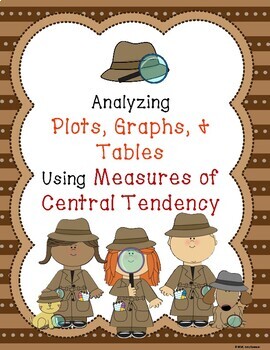Analyzing Plots, Graphs, and Tables using Measures of Central Tendency
- PDF
What educators are saying
Description
This product provides students the opportunity to analyze data presented in different ways. By making calculations and analyzing data, students make conjectures and justify them using mathematical reasoning and evidence!
What is included?
This product contains 8 student work pages. Each work page contains a set of data displayed graphically with accompanying questions. The data displays included are 2 dot plots, 2 bar graphs, 2 frequency tables, and 2 stem-and-leaf plots. Students are required to calculate mean, median, mode, and range from each data display. Students must analyze the data to determine the best measure of central tendency and justify their reasoning. Other questions are asked specific to the data display. For example, “How many total data points are shown in the stem-and-leaf plot?”
When should this worksheet be used?
Students should know how to find mean, median, mode, and range before beginning.
How will this worksheet enhance your lesson?
This product veers away from basic problems where students find measures of central tendency and spread from a simple list of data. By presenting data in different graphical representations, students must interpret the data before making calculations and conjectures. Finally, this product allows students to see how using measures of central tendency and spread can be useful in daily life by placing data sets in context.
This activity is aligned with common core standards 6.SP.A.2, 6.SP.A.3, 6.SP.B.4, 6.SP.B.5, 6.SP.B.5.A, 6.SP.B.5.B, 6.SP.B.5.C, and 6.SP.B.5.D.
*****************************************************************************
Recommendations for you:
CCSS 6.SP Examining Effects of Outliers on Measures of Central Tendency
CCSS 6.SP.3 6.SP.5c Measures of Central Tendency Practice
CCSS 6.SP.3c Using Mean to Solve Real-life Problems
CCSS 6.SP Station Task Cards: Best and Misleading Measures of Central Tendency
Analyzing a Frequency Table - Mean, Median, Mode, Range, Outliers
CCSS 6.SP.3 and 6.SP.5c Measures of Central Tendency Group Activity
CCSS 6.SP.3 Choosing Best Measure of Central Tendency
CCSS 6.SP.5c Mean and Outliers
*****************************************************************************
Customer Tips:
How to get TPT credit to use on future purchases:
• Please go to your My Purchases page (you may need to login). Beside each purchase you'll see a Provide Feedback button. Simply click it and you will be taken to a page where you can give a quick rating and leave a short comment for the product. Each time you give feedback, TPT gives you feedback credits that you use to lower the cost of your future purchases. I value your feedback greatly as it helps me determine which products are most valuable for your classroom so I can create more for you. ☺
Be the first to know about my new discounts, freebies and product launches:
• Look for the green star next to my store logo and click it to become a follower. Voila! You will now receive email updates about this store. ☺
*****************************************************************************





